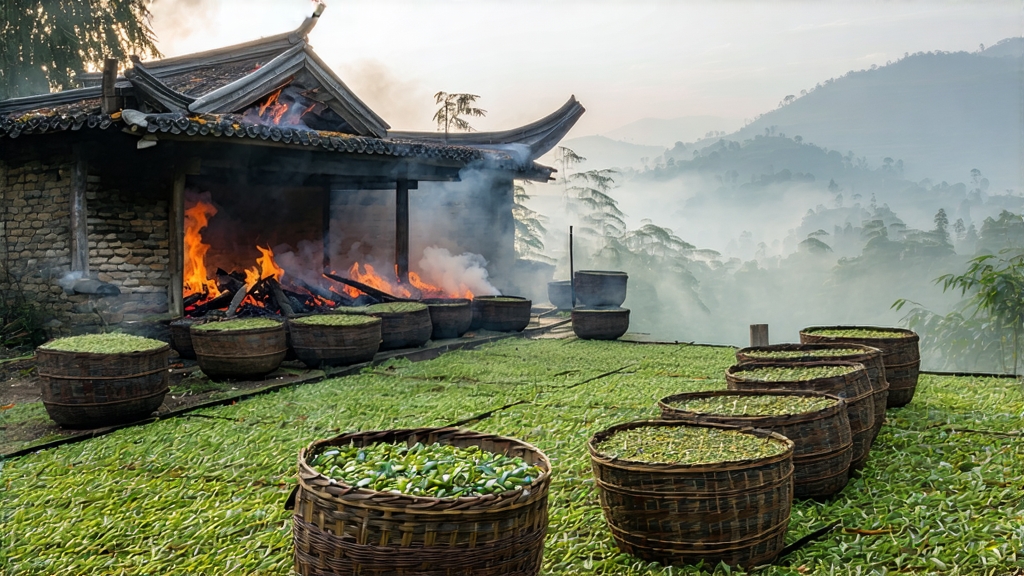
Long before English breakfast tables knew the word “black tea,” caravans carried small, leathery leaves out of the Wuyi Mountains of northern Fujian. These leaves, later christened Lapsang Souchong by 18th-century Dutch traders, were the first fully oxidised tea the West ever tasted. Their brisk liquor and surprising sweetness ignited a fashion that would topple green tea’s monopoly, fund clipper ships, and inspire Earl Grey’s perfumed recipe. Yet behind the global romance lies a quiet Chinese village—Tongmu Guan—where the same family clans still smoke tea over fresh pinewood in the same stone-walled workshops built during the late Ming dynasty.
History: from border garrison to London drawing room
Tongmu Guan sits inside a narrow gorge once garrisoned to repel Japanese pirates. When troop movements blocked the usual tea markets around 1600, local growers hastily dried their late-season leaves over available pine to prevent spoilage. The accidental smoke gave the tea a haunting resinous aroma that travelled well on humid caravan routes; by the time the cargo reached the port of Xiamen, European factors were paying double for “bohea” (the Fukienese pronunciation of “Wuyi”). By 1669 the British East India Company listed “Souchon” as a separate grade, and Queen Anne’s court adopted it as the base for the earliest English tea blends. The name itself is a linguistic palimpsest: “Lapsang” from the Fuzhou dialect lao san—“pine wood smoked”—and “Souchong” meaning “small sort,” the fourth and smallest leaf on the bush, prized for its concentrated sugars.
Terroir and cultivar
True Lapsang Souchong can only be produced inside the 565 km² Wuyi National Nature Reserve, a UNESCO dual heritage site whose mineral-rich, Danxia-red soils force tea roots to struggle, concentrating polyphenols and aromatic oils. The traditional cultivar is Xiao Ye Zhong (“small-leaf species”), a slow-growing shrub that buds only twice a year. Spring pickings deliver honeyed notes; the subtler autumn pickings carry higher terpene levels that marry gracefully with pine smoke. Outside the reserve, similar techniques yield “Waishan” (outside-mountain) styles, but connoisseurs insist the inner gorge’s cooler mist and diurnal temperature swing create an irreproducible sweetness known as “yan yun”—rock rhyme.
Pluck and wither
At dawn, women pluck the standard two leaves and a bud, but also include a fourth, older leaf—the souchong—whose thicker cuticle withstands smoking. The leaves are spread on large bamboo trays set into wooden racks inside the second story of the workshop, where gentle heat from the ground-floor hearth encourages primary wither. Here, moisture drops from 78 % to 58 % in four hours while enzymatic greenness fades to a dull olive. Crucially, the room is sealed against outside air; this traps leaf-borne lactones that later translate into dried-longan fragrance.
Rolling and oxidation
Once the leaves become pliable, they are rolled on rattan mats under foot pressure—still the preferred method because it bruises cells without overheating. The twisted strips are then heaped into deep bamboo baskets and covered with wet cloths to oxidise. In the cool mountain air this stage can last three hours, twice as long as lowland black teas. Oxidation is arrested the instant the leaf edge turns chestnut and the vein remains olive; over-oxidation would flatten the smoke layer that follows.
Smoke drying: the soul of Lapsang
While most black teas are baked, Lapsang enters a qinglóng—literally “green dragon”—a brick oven fed exclusively with local Masson pine and a little cedar root. Freshly split pinewood is lit, then immediately smothered to produce a cool, resinous smoke that drifts upward through perforated bamboo trays. The tea absorbs smoke in three passes: a 20-minute “soft” pass at 80 °C to set the leaf structure, a 40-minute “deep” pass at 60 °C to anchor phenolic compounds, and a final 10-minute “aroma” pass with moist spruce twigs to add top-note sweetness. Master smokers judge readiness by sound: when the crackle of resin subsides to a whisper